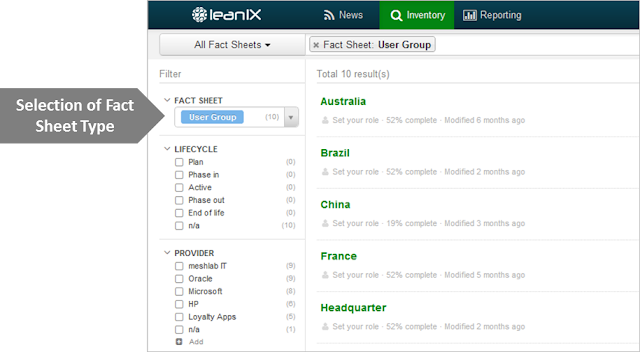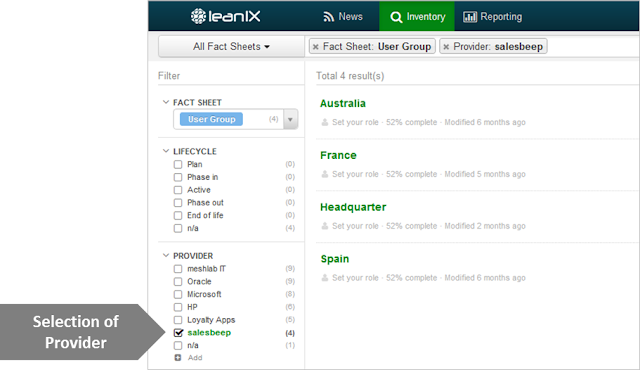Working with extensive data holds its own challenges. How can you retrieve the data you need out of the tons of available data. It gets even harder when you have to include logical connections between singular objects.
Looking at the management of IT portfolios, a good example are user groups that depend on a certain provider. IT is strongly debating how changes of providers are affecting the business. For our example we want to discuss the portfolio of an internationally working company. Here, user groups are national organizations, but you could also use business units or customer units.
Faceted search for modern users
We could have applied a unique query language to tackle this challenge, but leanIX applies modern user concepts. This includes facets that are already applied by e-commerce pages like amazon or by social communities like linkedIn or facebook. User already know facets, so it is not very difficult to work with them. Facets are really easy to understand, options for filtering are directly shown with their quantity and within one facet different options are available.We can tackle the challenges with only two clicks! The facets in leanIX are in the left side of the inventory.
Click 1: Choose your type of fact sheet. In our example it is user group. The content of the inventory is reduced only to the user group.
Click 2: Pick the provider that you are interested in - for our example: salesbeep. The content only shows the 4 user groups that are affected by salesbeep. Done!
The filter you applied is also shown in our header. Instead of using the facets you can also use the options within the header. This concept characterizes leanIX: We apply filter options as well for our reporting, so you have an interactive and easy option to make a “what – if” analysis.
Every type of Fact Sheet has its own facets that include extensive possibilities for queries. But there is more: Additionally, you can use facets in leanIX for data management. Every facet has a field “n/a” that displays directly all the information that is missing in order to make an evaluation of the fact sheet.
Conclusion
Facets in leanIX are ideal for queries, since they are easy to use and can be applied directly. No more need to waste time by programming queries. Since the number of facets in the left sidebar should not be too long, we already make a pre-selection, by only showing the most common queries. If these are not sufficient, you can export your query to Excel – one of the business tools that is supported in leanIX. With Excel several persons are able to do queries and work with pivot tables. All common requirements for queries are met with easy and well-known processes.



/EN/Reports/Thumbnail-Obsolescence-Gartner.png?width=140&height=100&name=Thumbnail-Obsolescence-Gartner.png)
/EN/White-Paper/EN-IDC-Inforbrief-Application-Rationalization-Portfolio-Management-Thumbnail_v2.png?width=140&height=99&name=EN-IDC-Inforbrief-Application-Rationalization-Portfolio-Management-Thumbnail_v2.png)
